Flexible Supply Chain Analysis: Spinneys Company Strategic Framework
VerifiedAdded on 2023/06/08
|11
|2451
|86
Report
AI Summary
This report provides an in-depth analysis of the importance of flexible supply chains, using Spinneys Company as a case study. It explores the company's strategic processes, including its approach to change management, risk mitigation, and globalization. The report examines Spinneys' strategic framework, highlighting key aspects such as consumer centricity, cost management, and the role of technology in enhancing supply chain visibility. It also delves into how Spinneys addresses various challenges, including competition, human risks, and changing consumer expectations in a global market. Furthermore, the report discusses the company's implementation of Total Quality Management (TQM) to improve supply chain standards and customer service. The analysis concludes by emphasizing the need for a flexible supply chain that can adapt to changing market demands and effectively manage costs and risks, ultimately ensuring customer satisfaction. The report also provides valuable insights into supply chain management practices within the retail sector.
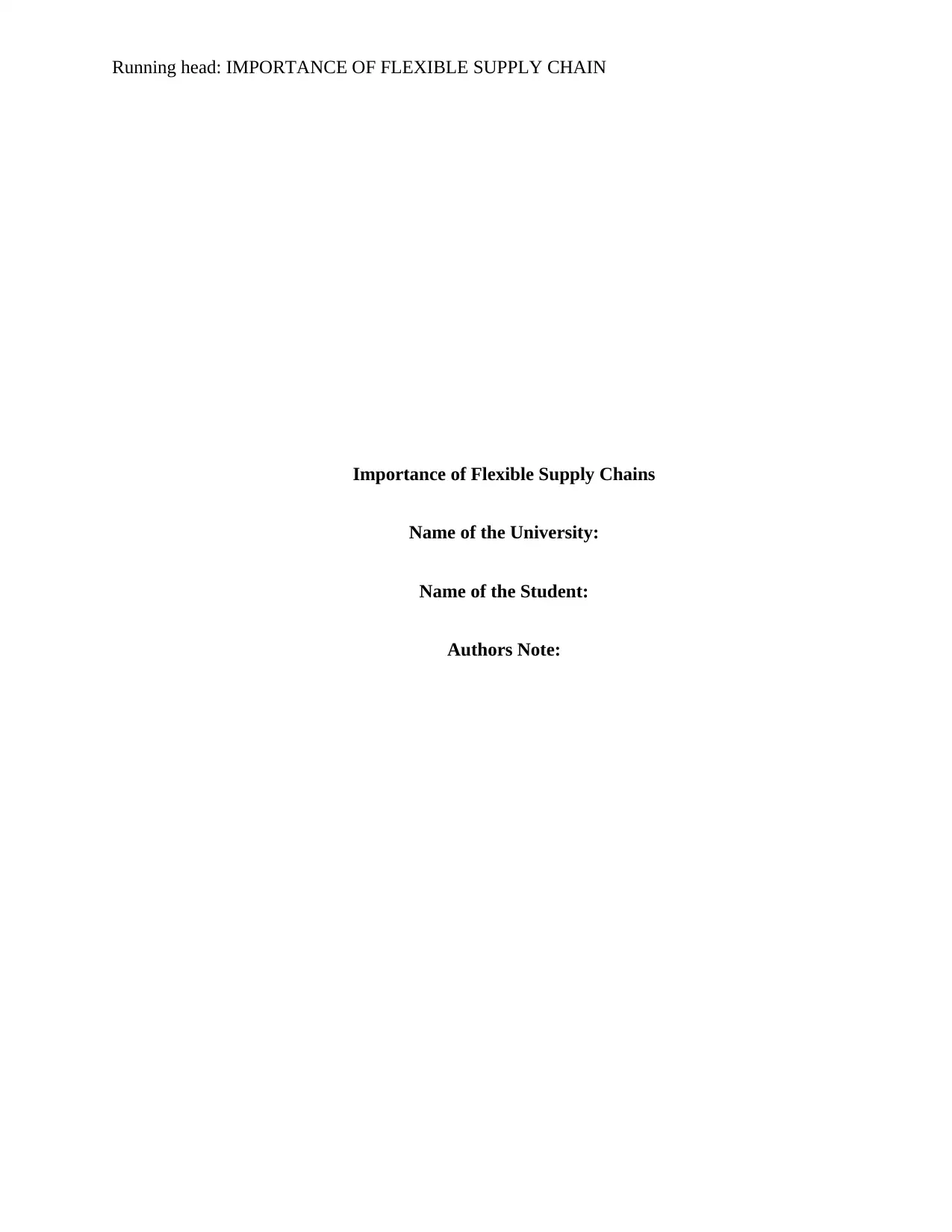
Running head: IMPORTANCE OF FLEXIBLE SUPPLY CHAIN
Importance of Flexible Supply Chains
Name of the University:
Name of the Student:
Authors Note:
Importance of Flexible Supply Chains
Name of the University:
Name of the Student:
Authors Note:
Paraphrase This Document
Need a fresh take? Get an instant paraphrase of this document with our AI Paraphraser
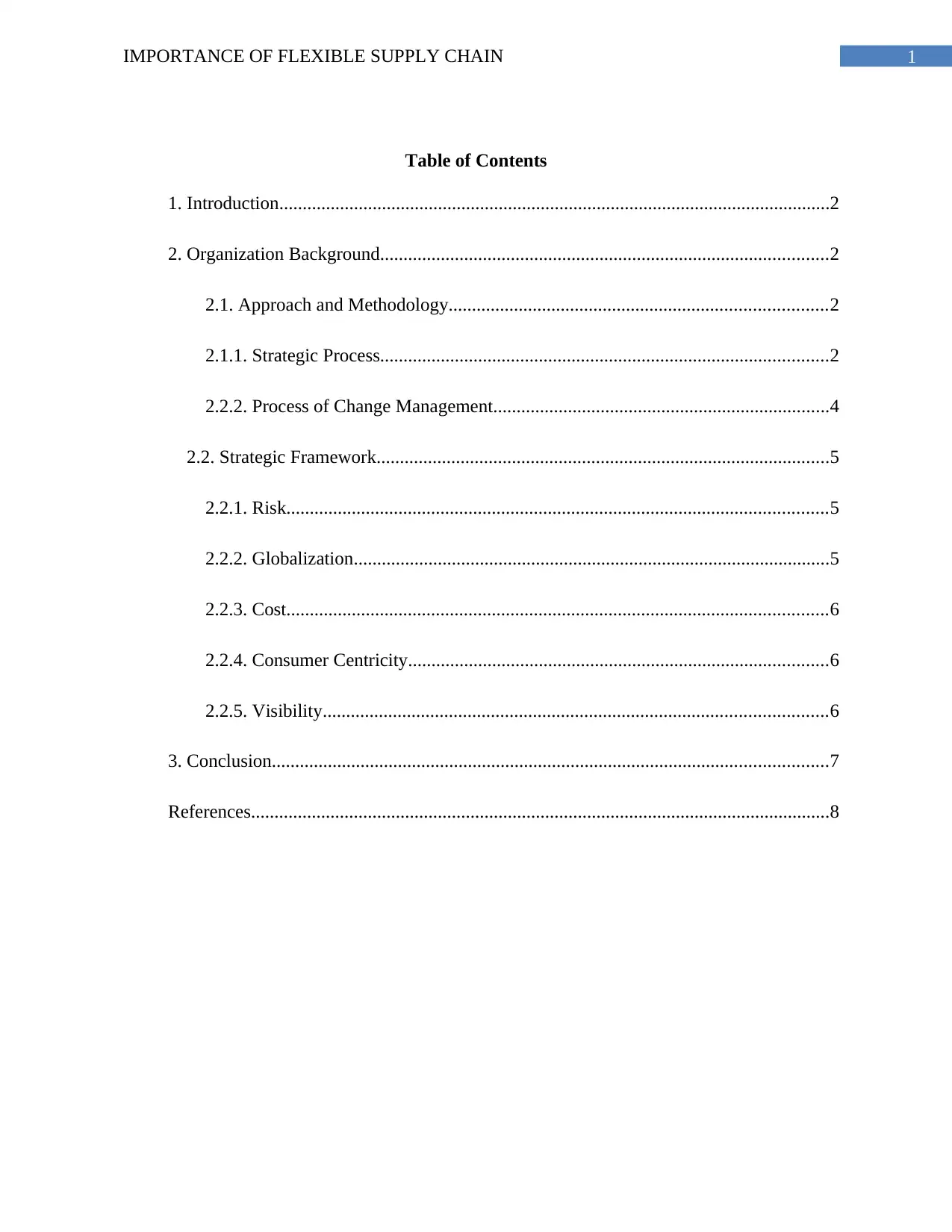
1IMPORTANCE OF FLEXIBLE SUPPLY CHAIN
Table of Contents
1. Introduction......................................................................................................................2
2. Organization Background................................................................................................2
2.1. Approach and Methodology.................................................................................2
2.1.1. Strategic Process................................................................................................2
2.2.2. Process of Change Management........................................................................4
2.2. Strategic Framework.................................................................................................5
2.2.1. Risk....................................................................................................................5
2.2.2. Globalization......................................................................................................5
2.2.3. Cost....................................................................................................................6
2.2.4. Consumer Centricity..........................................................................................6
2.2.5. Visibility............................................................................................................6
3. Conclusion.......................................................................................................................7
References............................................................................................................................8
Table of Contents
1. Introduction......................................................................................................................2
2. Organization Background................................................................................................2
2.1. Approach and Methodology.................................................................................2
2.1.1. Strategic Process................................................................................................2
2.2.2. Process of Change Management........................................................................4
2.2. Strategic Framework.................................................................................................5
2.2.1. Risk....................................................................................................................5
2.2.2. Globalization......................................................................................................5
2.2.3. Cost....................................................................................................................6
2.2.4. Consumer Centricity..........................................................................................6
2.2.5. Visibility............................................................................................................6
3. Conclusion.......................................................................................................................7
References............................................................................................................................8
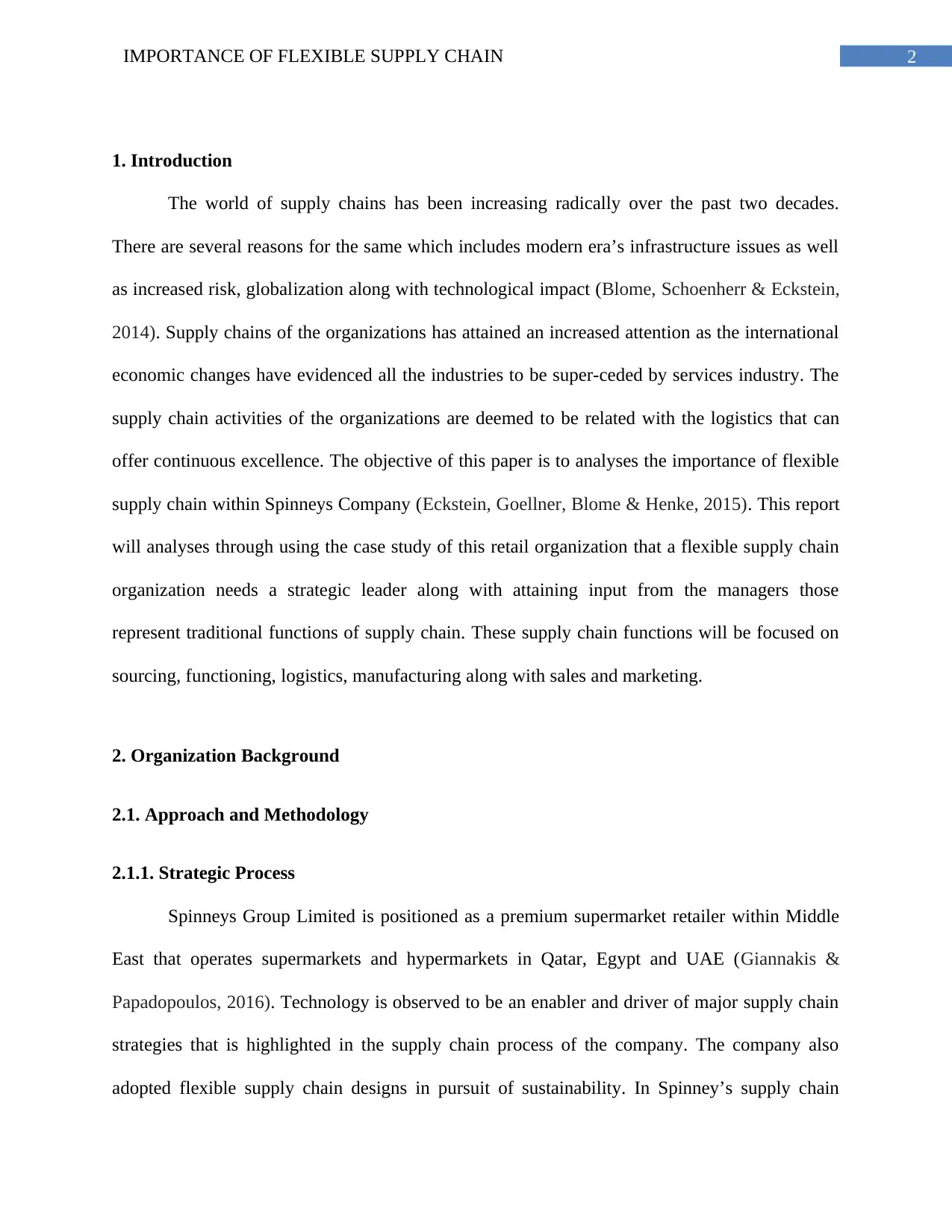
2IMPORTANCE OF FLEXIBLE SUPPLY CHAIN
1. Introduction
The world of supply chains has been increasing radically over the past two decades.
There are several reasons for the same which includes modern era’s infrastructure issues as well
as increased risk, globalization along with technological impact (Blome, Schoenherr & Eckstein,
2014). Supply chains of the organizations has attained an increased attention as the international
economic changes have evidenced all the industries to be super-ceded by services industry. The
supply chain activities of the organizations are deemed to be related with the logistics that can
offer continuous excellence. The objective of this paper is to analyses the importance of flexible
supply chain within Spinneys Company (Eckstein, Goellner, Blome & Henke, 2015). This report
will analyses through using the case study of this retail organization that a flexible supply chain
organization needs a strategic leader along with attaining input from the managers those
represent traditional functions of supply chain. These supply chain functions will be focused on
sourcing, functioning, logistics, manufacturing along with sales and marketing.
2. Organization Background
2.1. Approach and Methodology
2.1.1. Strategic Process
Spinneys Group Limited is positioned as a premium supermarket retailer within Middle
East that operates supermarkets and hypermarkets in Qatar, Egypt and UAE (Giannakis &
Papadopoulos, 2016). Technology is observed to be an enabler and driver of major supply chain
strategies that is highlighted in the supply chain process of the company. The company also
adopted flexible supply chain designs in pursuit of sustainability. In Spinney’s supply chain
1. Introduction
The world of supply chains has been increasing radically over the past two decades.
There are several reasons for the same which includes modern era’s infrastructure issues as well
as increased risk, globalization along with technological impact (Blome, Schoenherr & Eckstein,
2014). Supply chains of the organizations has attained an increased attention as the international
economic changes have evidenced all the industries to be super-ceded by services industry. The
supply chain activities of the organizations are deemed to be related with the logistics that can
offer continuous excellence. The objective of this paper is to analyses the importance of flexible
supply chain within Spinneys Company (Eckstein, Goellner, Blome & Henke, 2015). This report
will analyses through using the case study of this retail organization that a flexible supply chain
organization needs a strategic leader along with attaining input from the managers those
represent traditional functions of supply chain. These supply chain functions will be focused on
sourcing, functioning, logistics, manufacturing along with sales and marketing.
2. Organization Background
2.1. Approach and Methodology
2.1.1. Strategic Process
Spinneys Group Limited is positioned as a premium supermarket retailer within Middle
East that operates supermarkets and hypermarkets in Qatar, Egypt and UAE (Giannakis &
Papadopoulos, 2016). Technology is observed to be an enabler and driver of major supply chain
strategies that is highlighted in the supply chain process of the company. The company also
adopted flexible supply chain designs in pursuit of sustainability. In Spinney’s supply chain
⊘ This is a preview!⊘
Do you want full access?
Subscribe today to unlock all pages.

Trusted by 1+ million students worldwide
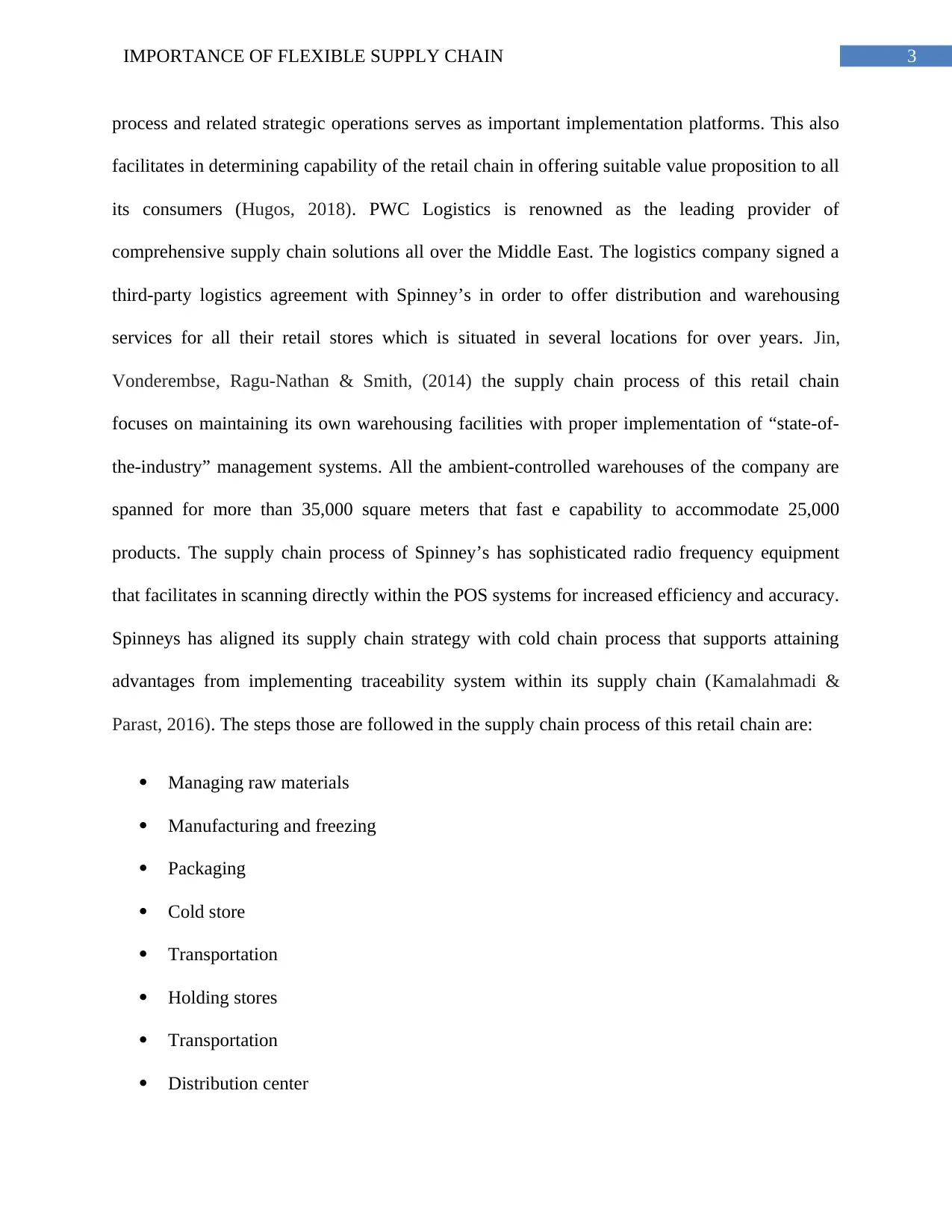
3IMPORTANCE OF FLEXIBLE SUPPLY CHAIN
process and related strategic operations serves as important implementation platforms. This also
facilitates in determining capability of the retail chain in offering suitable value proposition to all
its consumers (Hugos, 2018). PWC Logistics is renowned as the leading provider of
comprehensive supply chain solutions all over the Middle East. The logistics company signed a
third-party logistics agreement with Spinney’s in order to offer distribution and warehousing
services for all their retail stores which is situated in several locations for over years. Jin,
Vonderembse, Ragu-Nathan & Smith, (2014) the supply chain process of this retail chain
focuses on maintaining its own warehousing facilities with proper implementation of “state-of-
the-industry” management systems. All the ambient-controlled warehouses of the company are
spanned for more than 35,000 square meters that fast e capability to accommodate 25,000
products. The supply chain process of Spinney’s has sophisticated radio frequency equipment
that facilitates in scanning directly within the POS systems for increased efficiency and accuracy.
Spinneys has aligned its supply chain strategy with cold chain process that supports attaining
advantages from implementing traceability system within its supply chain (Kamalahmadi &
Parast, 2016). The steps those are followed in the supply chain process of this retail chain are:
Managing raw materials
Manufacturing and freezing
Packaging
Cold store
Transportation
Holding stores
Transportation
Distribution center
process and related strategic operations serves as important implementation platforms. This also
facilitates in determining capability of the retail chain in offering suitable value proposition to all
its consumers (Hugos, 2018). PWC Logistics is renowned as the leading provider of
comprehensive supply chain solutions all over the Middle East. The logistics company signed a
third-party logistics agreement with Spinney’s in order to offer distribution and warehousing
services for all their retail stores which is situated in several locations for over years. Jin,
Vonderembse, Ragu-Nathan & Smith, (2014) the supply chain process of this retail chain
focuses on maintaining its own warehousing facilities with proper implementation of “state-of-
the-industry” management systems. All the ambient-controlled warehouses of the company are
spanned for more than 35,000 square meters that fast e capability to accommodate 25,000
products. The supply chain process of Spinney’s has sophisticated radio frequency equipment
that facilitates in scanning directly within the POS systems for increased efficiency and accuracy.
Spinneys has aligned its supply chain strategy with cold chain process that supports attaining
advantages from implementing traceability system within its supply chain (Kamalahmadi &
Parast, 2016). The steps those are followed in the supply chain process of this retail chain are:
Managing raw materials
Manufacturing and freezing
Packaging
Cold store
Transportation
Holding stores
Transportation
Distribution center
Paraphrase This Document
Need a fresh take? Get an instant paraphrase of this document with our AI Paraphraser
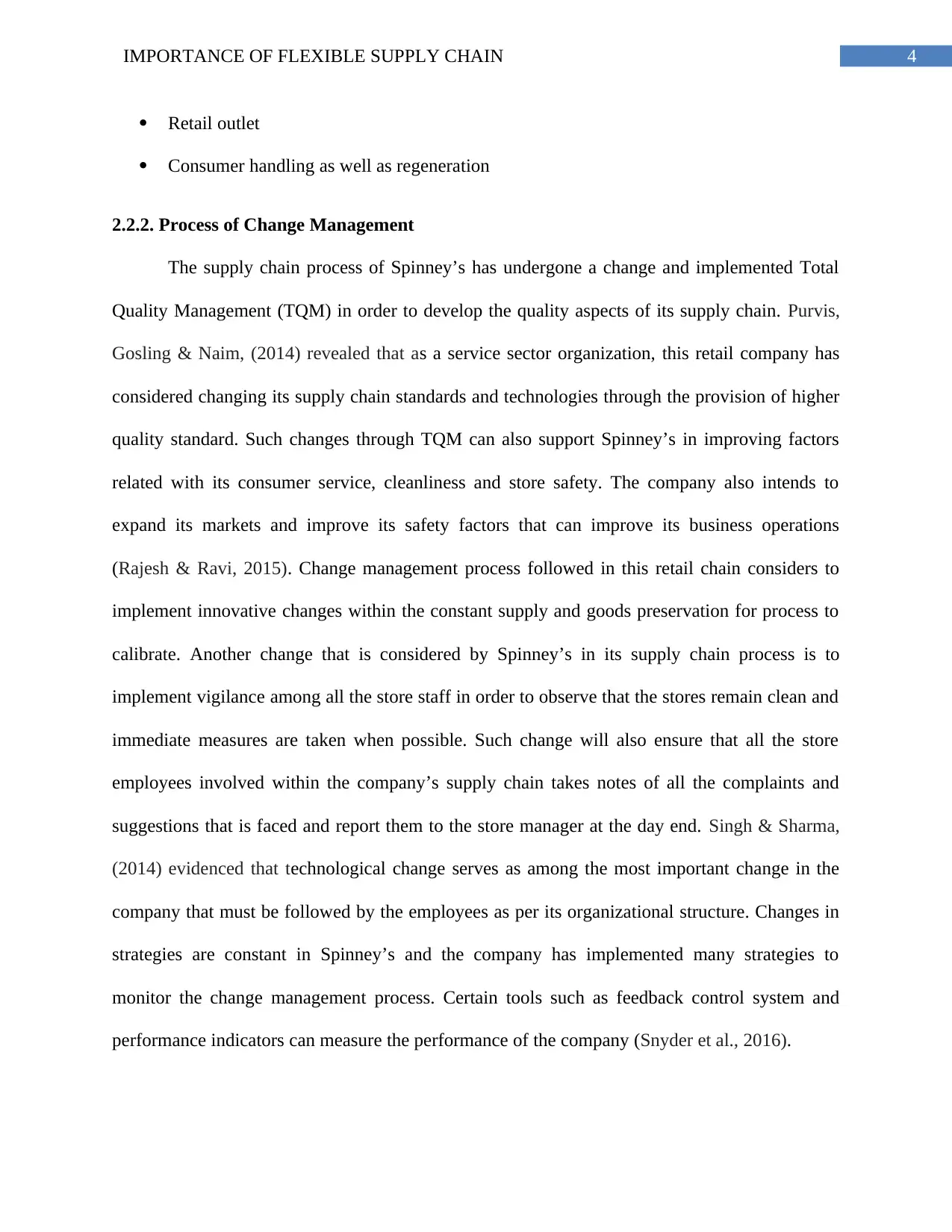
4IMPORTANCE OF FLEXIBLE SUPPLY CHAIN
Retail outlet
Consumer handling as well as regeneration
2.2.2. Process of Change Management
The supply chain process of Spinney’s has undergone a change and implemented Total
Quality Management (TQM) in order to develop the quality aspects of its supply chain. Purvis,
Gosling & Naim, (2014) revealed that as a service sector organization, this retail company has
considered changing its supply chain standards and technologies through the provision of higher
quality standard. Such changes through TQM can also support Spinney’s in improving factors
related with its consumer service, cleanliness and store safety. The company also intends to
expand its markets and improve its safety factors that can improve its business operations
(Rajesh & Ravi, 2015). Change management process followed in this retail chain considers to
implement innovative changes within the constant supply and goods preservation for process to
calibrate. Another change that is considered by Spinney’s in its supply chain process is to
implement vigilance among all the store staff in order to observe that the stores remain clean and
immediate measures are taken when possible. Such change will also ensure that all the store
employees involved within the company’s supply chain takes notes of all the complaints and
suggestions that is faced and report them to the store manager at the day end. Singh & Sharma,
(2014) evidenced that technological change serves as among the most important change in the
company that must be followed by the employees as per its organizational structure. Changes in
strategies are constant in Spinney’s and the company has implemented many strategies to
monitor the change management process. Certain tools such as feedback control system and
performance indicators can measure the performance of the company (Snyder et al., 2016).
Retail outlet
Consumer handling as well as regeneration
2.2.2. Process of Change Management
The supply chain process of Spinney’s has undergone a change and implemented Total
Quality Management (TQM) in order to develop the quality aspects of its supply chain. Purvis,
Gosling & Naim, (2014) revealed that as a service sector organization, this retail company has
considered changing its supply chain standards and technologies through the provision of higher
quality standard. Such changes through TQM can also support Spinney’s in improving factors
related with its consumer service, cleanliness and store safety. The company also intends to
expand its markets and improve its safety factors that can improve its business operations
(Rajesh & Ravi, 2015). Change management process followed in this retail chain considers to
implement innovative changes within the constant supply and goods preservation for process to
calibrate. Another change that is considered by Spinney’s in its supply chain process is to
implement vigilance among all the store staff in order to observe that the stores remain clean and
immediate measures are taken when possible. Such change will also ensure that all the store
employees involved within the company’s supply chain takes notes of all the complaints and
suggestions that is faced and report them to the store manager at the day end. Singh & Sharma,
(2014) evidenced that technological change serves as among the most important change in the
company that must be followed by the employees as per its organizational structure. Changes in
strategies are constant in Spinney’s and the company has implemented many strategies to
monitor the change management process. Certain tools such as feedback control system and
performance indicators can measure the performance of the company (Snyder et al., 2016).
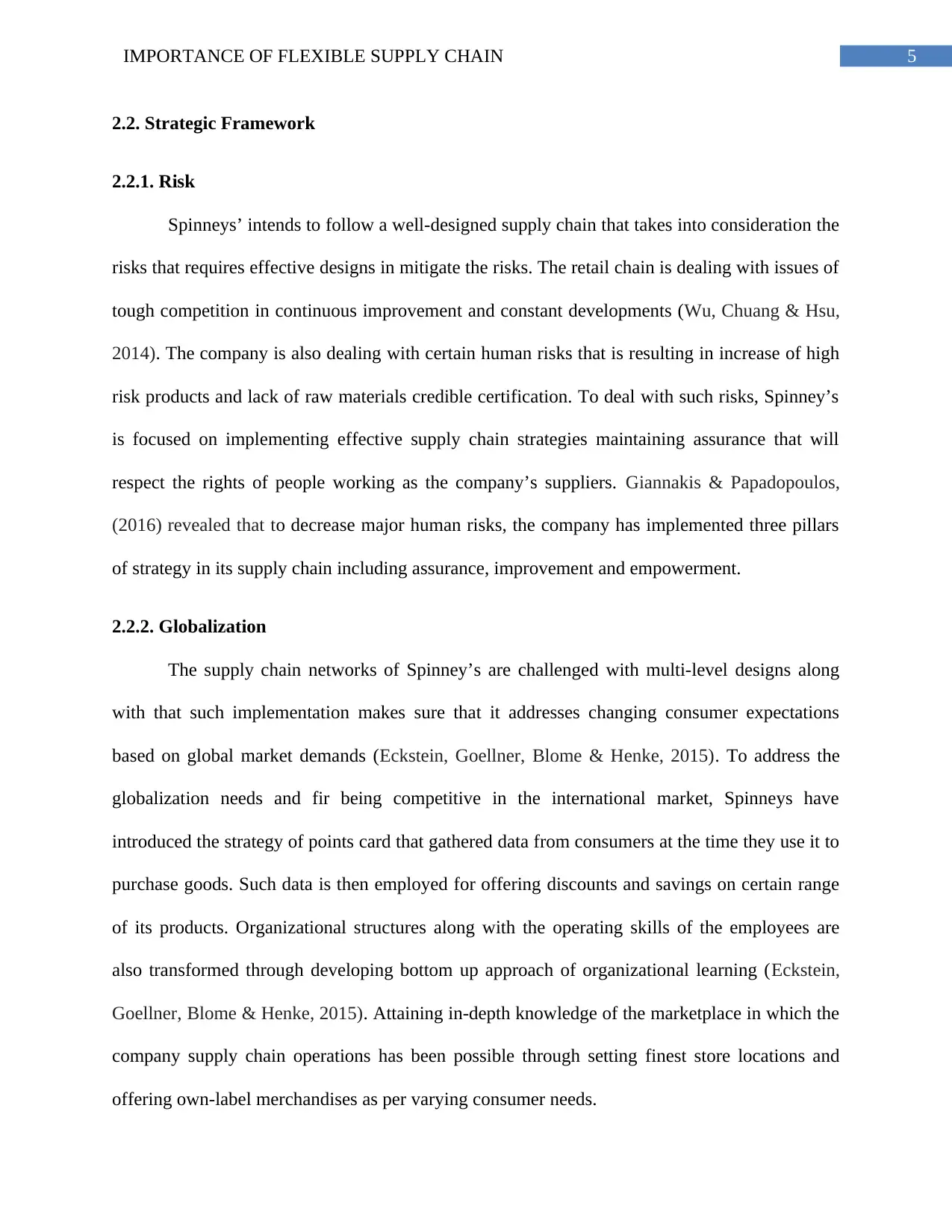
5IMPORTANCE OF FLEXIBLE SUPPLY CHAIN
2.2. Strategic Framework
2.2.1. Risk
Spinneys’ intends to follow a well-designed supply chain that takes into consideration the
risks that requires effective designs in mitigate the risks. The retail chain is dealing with issues of
tough competition in continuous improvement and constant developments (Wu, Chuang & Hsu,
2014). The company is also dealing with certain human risks that is resulting in increase of high
risk products and lack of raw materials credible certification. To deal with such risks, Spinney’s
is focused on implementing effective supply chain strategies maintaining assurance that will
respect the rights of people working as the company’s suppliers. Giannakis & Papadopoulos,
(2016) revealed that to decrease major human risks, the company has implemented three pillars
of strategy in its supply chain including assurance, improvement and empowerment.
2.2.2. Globalization
The supply chain networks of Spinney’s are challenged with multi-level designs along
with that such implementation makes sure that it addresses changing consumer expectations
based on global market demands (Eckstein, Goellner, Blome & Henke, 2015). To address the
globalization needs and fir being competitive in the international market, Spinneys have
introduced the strategy of points card that gathered data from consumers at the time they use it to
purchase goods. Such data is then employed for offering discounts and savings on certain range
of its products. Organizational structures along with the operating skills of the employees are
also transformed through developing bottom up approach of organizational learning (Eckstein,
Goellner, Blome & Henke, 2015). Attaining in-depth knowledge of the marketplace in which the
company supply chain operations has been possible through setting finest store locations and
offering own-label merchandises as per varying consumer needs.
2.2. Strategic Framework
2.2.1. Risk
Spinneys’ intends to follow a well-designed supply chain that takes into consideration the
risks that requires effective designs in mitigate the risks. The retail chain is dealing with issues of
tough competition in continuous improvement and constant developments (Wu, Chuang & Hsu,
2014). The company is also dealing with certain human risks that is resulting in increase of high
risk products and lack of raw materials credible certification. To deal with such risks, Spinney’s
is focused on implementing effective supply chain strategies maintaining assurance that will
respect the rights of people working as the company’s suppliers. Giannakis & Papadopoulos,
(2016) revealed that to decrease major human risks, the company has implemented three pillars
of strategy in its supply chain including assurance, improvement and empowerment.
2.2.2. Globalization
The supply chain networks of Spinney’s are challenged with multi-level designs along
with that such implementation makes sure that it addresses changing consumer expectations
based on global market demands (Eckstein, Goellner, Blome & Henke, 2015). To address the
globalization needs and fir being competitive in the international market, Spinneys have
introduced the strategy of points card that gathered data from consumers at the time they use it to
purchase goods. Such data is then employed for offering discounts and savings on certain range
of its products. Organizational structures along with the operating skills of the employees are
also transformed through developing bottom up approach of organizational learning (Eckstein,
Goellner, Blome & Henke, 2015). Attaining in-depth knowledge of the marketplace in which the
company supply chain operations has been possible through setting finest store locations and
offering own-label merchandises as per varying consumer needs.
⊘ This is a preview!⊘
Do you want full access?
Subscribe today to unlock all pages.

Trusted by 1+ million students worldwide
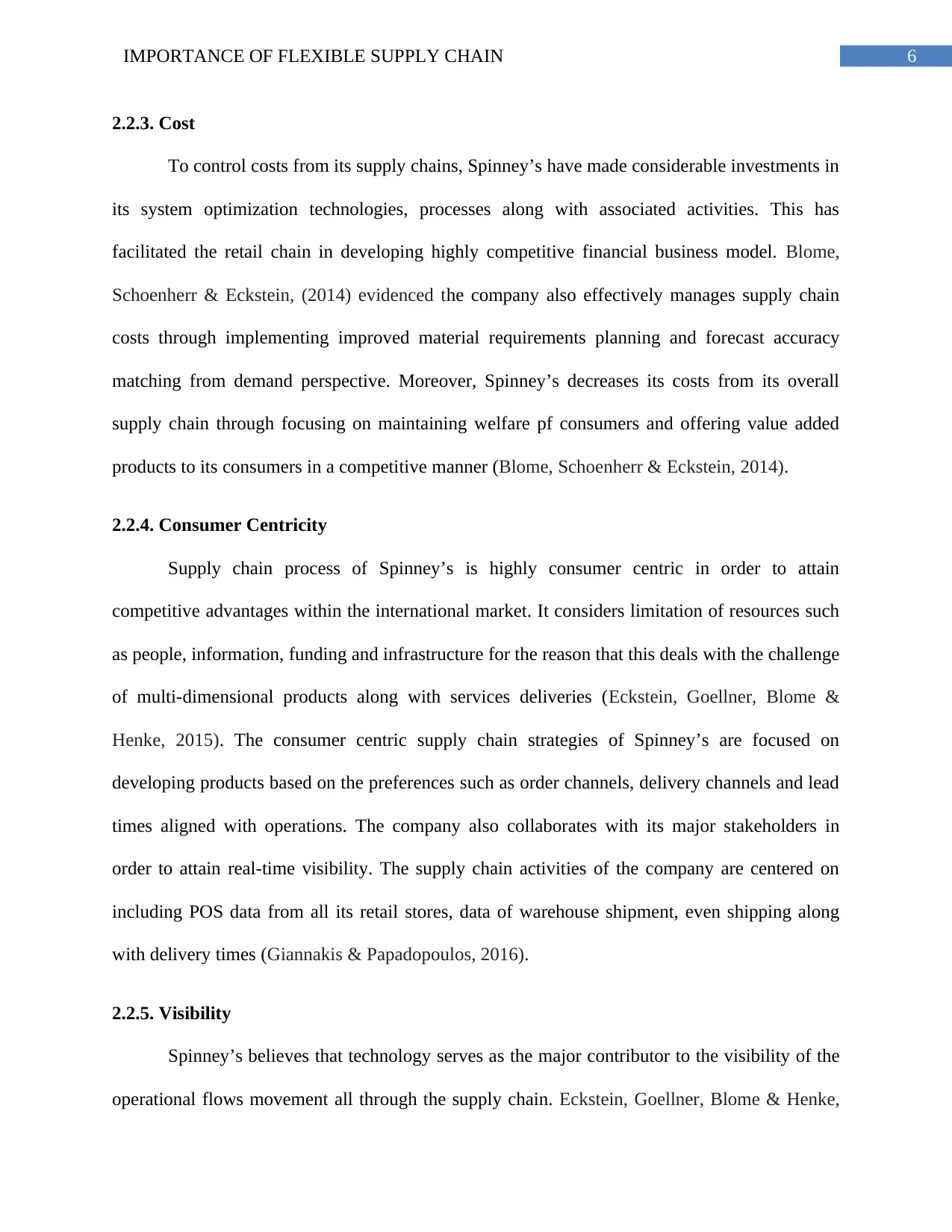
6IMPORTANCE OF FLEXIBLE SUPPLY CHAIN
2.2.3. Cost
To control costs from its supply chains, Spinney’s have made considerable investments in
its system optimization technologies, processes along with associated activities. This has
facilitated the retail chain in developing highly competitive financial business model. Blome,
Schoenherr & Eckstein, (2014) evidenced the company also effectively manages supply chain
costs through implementing improved material requirements planning and forecast accuracy
matching from demand perspective. Moreover, Spinney’s decreases its costs from its overall
supply chain through focusing on maintaining welfare pf consumers and offering value added
products to its consumers in a competitive manner (Blome, Schoenherr & Eckstein, 2014).
2.2.4. Consumer Centricity
Supply chain process of Spinney’s is highly consumer centric in order to attain
competitive advantages within the international market. It considers limitation of resources such
as people, information, funding and infrastructure for the reason that this deals with the challenge
of multi-dimensional products along with services deliveries (Eckstein, Goellner, Blome &
Henke, 2015). The consumer centric supply chain strategies of Spinney’s are focused on
developing products based on the preferences such as order channels, delivery channels and lead
times aligned with operations. The company also collaborates with its major stakeholders in
order to attain real-time visibility. The supply chain activities of the company are centered on
including POS data from all its retail stores, data of warehouse shipment, even shipping along
with delivery times (Giannakis & Papadopoulos, 2016).
2.2.5. Visibility
Spinney’s believes that technology serves as the major contributor to the visibility of the
operational flows movement all through the supply chain. Eckstein, Goellner, Blome & Henke,
2.2.3. Cost
To control costs from its supply chains, Spinney’s have made considerable investments in
its system optimization technologies, processes along with associated activities. This has
facilitated the retail chain in developing highly competitive financial business model. Blome,
Schoenherr & Eckstein, (2014) evidenced the company also effectively manages supply chain
costs through implementing improved material requirements planning and forecast accuracy
matching from demand perspective. Moreover, Spinney’s decreases its costs from its overall
supply chain through focusing on maintaining welfare pf consumers and offering value added
products to its consumers in a competitive manner (Blome, Schoenherr & Eckstein, 2014).
2.2.4. Consumer Centricity
Supply chain process of Spinney’s is highly consumer centric in order to attain
competitive advantages within the international market. It considers limitation of resources such
as people, information, funding and infrastructure for the reason that this deals with the challenge
of multi-dimensional products along with services deliveries (Eckstein, Goellner, Blome &
Henke, 2015). The consumer centric supply chain strategies of Spinney’s are focused on
developing products based on the preferences such as order channels, delivery channels and lead
times aligned with operations. The company also collaborates with its major stakeholders in
order to attain real-time visibility. The supply chain activities of the company are centered on
including POS data from all its retail stores, data of warehouse shipment, even shipping along
with delivery times (Giannakis & Papadopoulos, 2016).
2.2.5. Visibility
Spinney’s believes that technology serves as the major contributor to the visibility of the
operational flows movement all through the supply chain. Eckstein, Goellner, Blome & Henke,
Paraphrase This Document
Need a fresh take? Get an instant paraphrase of this document with our AI Paraphraser
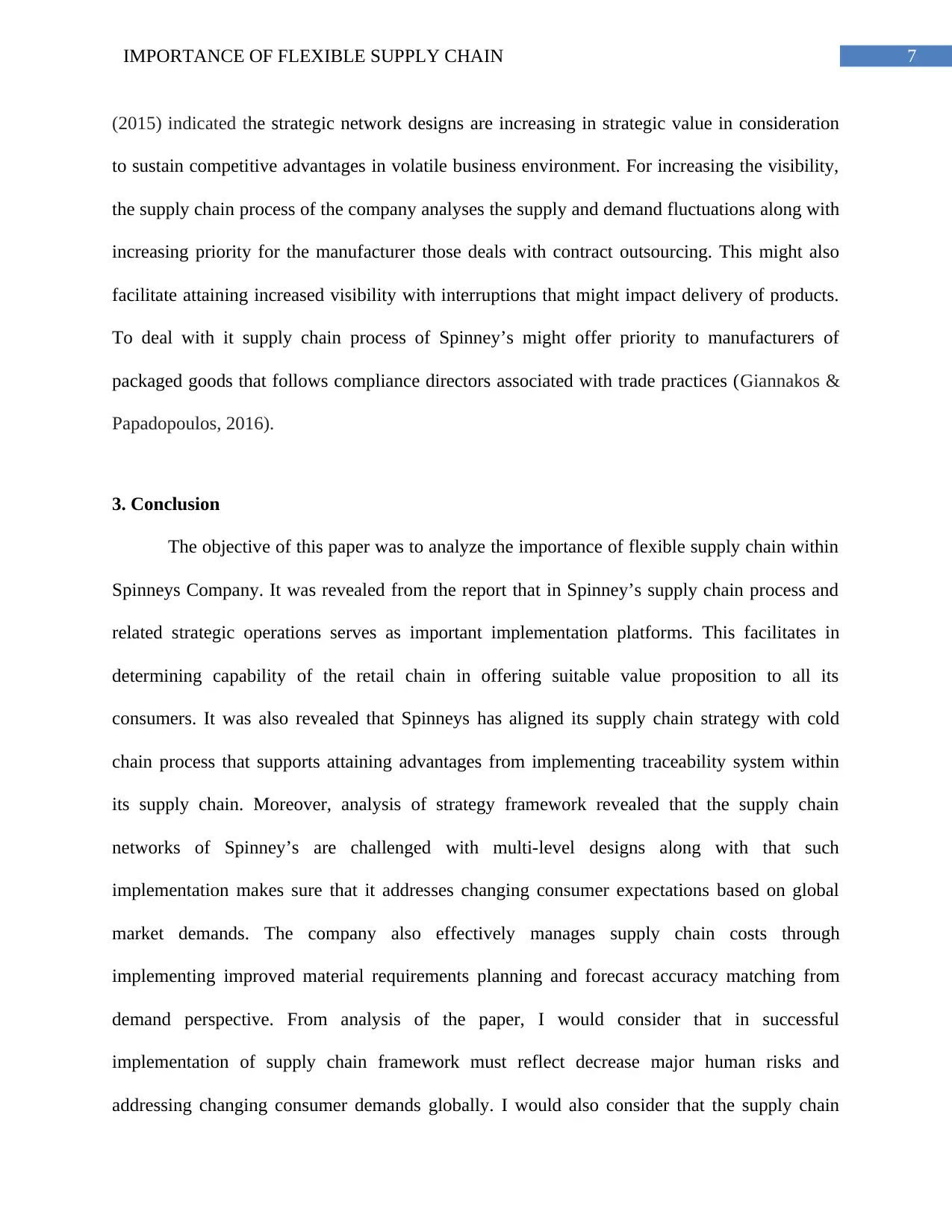
7IMPORTANCE OF FLEXIBLE SUPPLY CHAIN
(2015) indicated the strategic network designs are increasing in strategic value in consideration
to sustain competitive advantages in volatile business environment. For increasing the visibility,
the supply chain process of the company analyses the supply and demand fluctuations along with
increasing priority for the manufacturer those deals with contract outsourcing. This might also
facilitate attaining increased visibility with interruptions that might impact delivery of products.
To deal with it supply chain process of Spinney’s might offer priority to manufacturers of
packaged goods that follows compliance directors associated with trade practices (Giannakos &
Papadopoulos, 2016).
3. Conclusion
The objective of this paper was to analyze the importance of flexible supply chain within
Spinneys Company. It was revealed from the report that in Spinney’s supply chain process and
related strategic operations serves as important implementation platforms. This facilitates in
determining capability of the retail chain in offering suitable value proposition to all its
consumers. It was also revealed that Spinneys has aligned its supply chain strategy with cold
chain process that supports attaining advantages from implementing traceability system within
its supply chain. Moreover, analysis of strategy framework revealed that the supply chain
networks of Spinney’s are challenged with multi-level designs along with that such
implementation makes sure that it addresses changing consumer expectations based on global
market demands. The company also effectively manages supply chain costs through
implementing improved material requirements planning and forecast accuracy matching from
demand perspective. From analysis of the paper, I would consider that in successful
implementation of supply chain framework must reflect decrease major human risks and
addressing changing consumer demands globally. I would also consider that the supply chain
(2015) indicated the strategic network designs are increasing in strategic value in consideration
to sustain competitive advantages in volatile business environment. For increasing the visibility,
the supply chain process of the company analyses the supply and demand fluctuations along with
increasing priority for the manufacturer those deals with contract outsourcing. This might also
facilitate attaining increased visibility with interruptions that might impact delivery of products.
To deal with it supply chain process of Spinney’s might offer priority to manufacturers of
packaged goods that follows compliance directors associated with trade practices (Giannakos &
Papadopoulos, 2016).
3. Conclusion
The objective of this paper was to analyze the importance of flexible supply chain within
Spinneys Company. It was revealed from the report that in Spinney’s supply chain process and
related strategic operations serves as important implementation platforms. This facilitates in
determining capability of the retail chain in offering suitable value proposition to all its
consumers. It was also revealed that Spinneys has aligned its supply chain strategy with cold
chain process that supports attaining advantages from implementing traceability system within
its supply chain. Moreover, analysis of strategy framework revealed that the supply chain
networks of Spinney’s are challenged with multi-level designs along with that such
implementation makes sure that it addresses changing consumer expectations based on global
market demands. The company also effectively manages supply chain costs through
implementing improved material requirements planning and forecast accuracy matching from
demand perspective. From analysis of the paper, I would consider that in successful
implementation of supply chain framework must reflect decrease major human risks and
addressing changing consumer demands globally. I would also consider that the supply chain

8IMPORTANCE OF FLEXIBLE SUPPLY CHAIN
framework must implement material requirement planning and forecasting for controlling supply
chain costs.
framework must implement material requirement planning and forecasting for controlling supply
chain costs.
⊘ This is a preview!⊘
Do you want full access?
Subscribe today to unlock all pages.

Trusted by 1+ million students worldwide
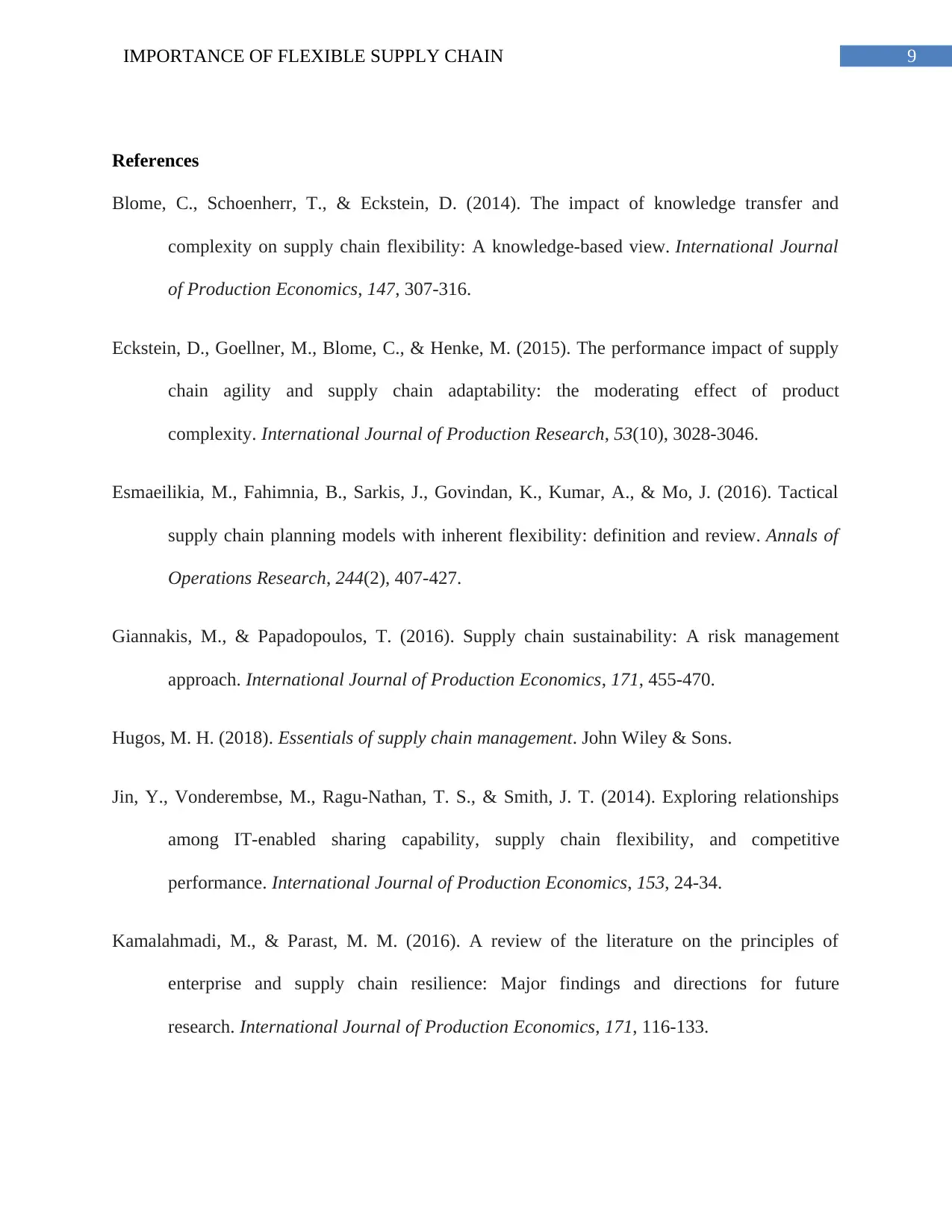
9IMPORTANCE OF FLEXIBLE SUPPLY CHAIN
References
Blome, C., Schoenherr, T., & Eckstein, D. (2014). The impact of knowledge transfer and
complexity on supply chain flexibility: A knowledge-based view. International Journal
of Production Economics, 147, 307-316.
Eckstein, D., Goellner, M., Blome, C., & Henke, M. (2015). The performance impact of supply
chain agility and supply chain adaptability: the moderating effect of product
complexity. International Journal of Production Research, 53(10), 3028-3046.
Esmaeilikia, M., Fahimnia, B., Sarkis, J., Govindan, K., Kumar, A., & Mo, J. (2016). Tactical
supply chain planning models with inherent flexibility: definition and review. Annals of
Operations Research, 244(2), 407-427.
Giannakis, M., & Papadopoulos, T. (2016). Supply chain sustainability: A risk management
approach. International Journal of Production Economics, 171, 455-470.
Hugos, M. H. (2018). Essentials of supply chain management. John Wiley & Sons.
Jin, Y., Vonderembse, M., Ragu-Nathan, T. S., & Smith, J. T. (2014). Exploring relationships
among IT-enabled sharing capability, supply chain flexibility, and competitive
performance. International Journal of Production Economics, 153, 24-34.
Kamalahmadi, M., & Parast, M. M. (2016). A review of the literature on the principles of
enterprise and supply chain resilience: Major findings and directions for future
research. International Journal of Production Economics, 171, 116-133.
References
Blome, C., Schoenherr, T., & Eckstein, D. (2014). The impact of knowledge transfer and
complexity on supply chain flexibility: A knowledge-based view. International Journal
of Production Economics, 147, 307-316.
Eckstein, D., Goellner, M., Blome, C., & Henke, M. (2015). The performance impact of supply
chain agility and supply chain adaptability: the moderating effect of product
complexity. International Journal of Production Research, 53(10), 3028-3046.
Esmaeilikia, M., Fahimnia, B., Sarkis, J., Govindan, K., Kumar, A., & Mo, J. (2016). Tactical
supply chain planning models with inherent flexibility: definition and review. Annals of
Operations Research, 244(2), 407-427.
Giannakis, M., & Papadopoulos, T. (2016). Supply chain sustainability: A risk management
approach. International Journal of Production Economics, 171, 455-470.
Hugos, M. H. (2018). Essentials of supply chain management. John Wiley & Sons.
Jin, Y., Vonderembse, M., Ragu-Nathan, T. S., & Smith, J. T. (2014). Exploring relationships
among IT-enabled sharing capability, supply chain flexibility, and competitive
performance. International Journal of Production Economics, 153, 24-34.
Kamalahmadi, M., & Parast, M. M. (2016). A review of the literature on the principles of
enterprise and supply chain resilience: Major findings and directions for future
research. International Journal of Production Economics, 171, 116-133.
Paraphrase This Document
Need a fresh take? Get an instant paraphrase of this document with our AI Paraphraser
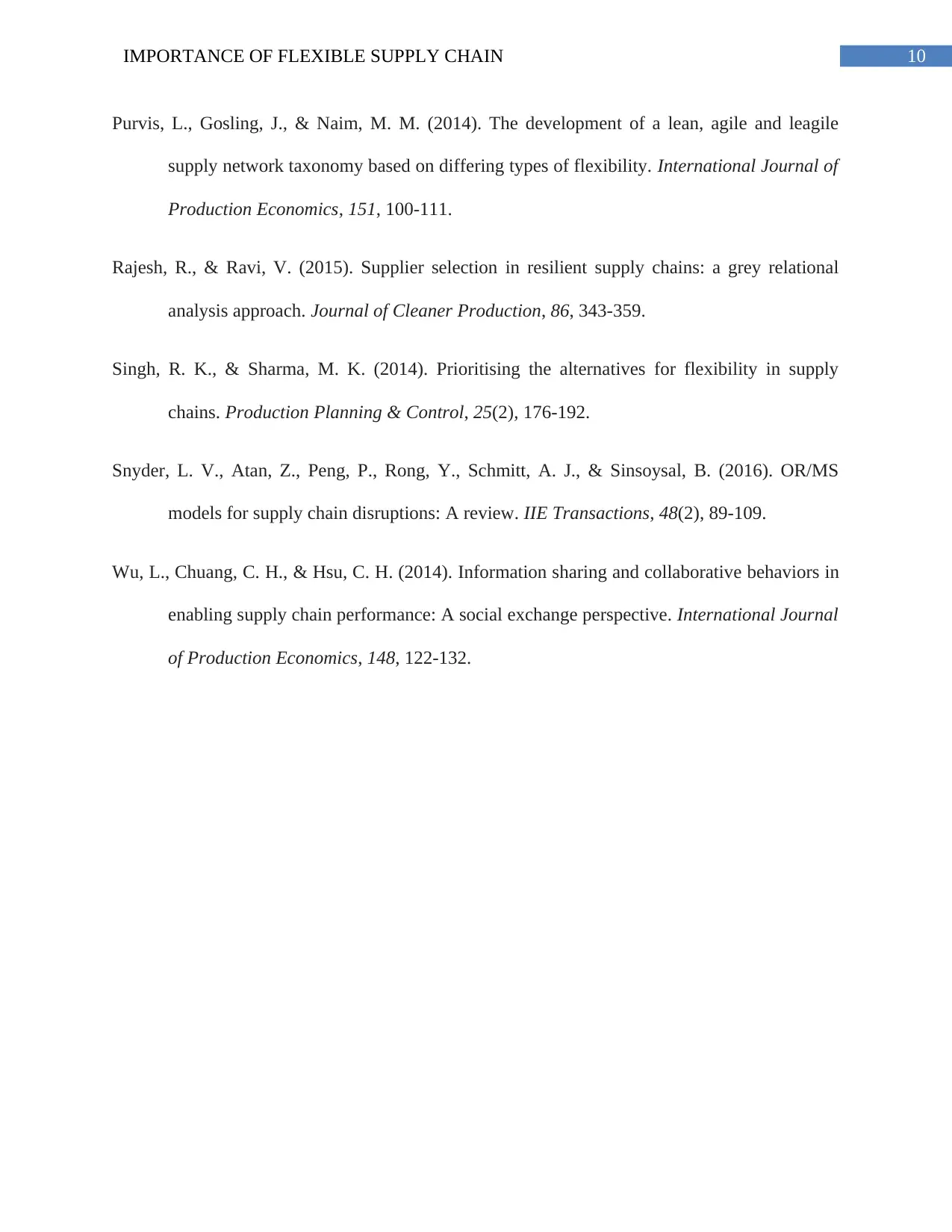
10IMPORTANCE OF FLEXIBLE SUPPLY CHAIN
Purvis, L., Gosling, J., & Naim, M. M. (2014). The development of a lean, agile and leagile
supply network taxonomy based on differing types of flexibility. International Journal of
Production Economics, 151, 100-111.
Rajesh, R., & Ravi, V. (2015). Supplier selection in resilient supply chains: a grey relational
analysis approach. Journal of Cleaner Production, 86, 343-359.
Singh, R. K., & Sharma, M. K. (2014). Prioritising the alternatives for flexibility in supply
chains. Production Planning & Control, 25(2), 176-192.
Snyder, L. V., Atan, Z., Peng, P., Rong, Y., Schmitt, A. J., & Sinsoysal, B. (2016). OR/MS
models for supply chain disruptions: A review. IIE Transactions, 48(2), 89-109.
Wu, L., Chuang, C. H., & Hsu, C. H. (2014). Information sharing and collaborative behaviors in
enabling supply chain performance: A social exchange perspective. International Journal
of Production Economics, 148, 122-132.
Purvis, L., Gosling, J., & Naim, M. M. (2014). The development of a lean, agile and leagile
supply network taxonomy based on differing types of flexibility. International Journal of
Production Economics, 151, 100-111.
Rajesh, R., & Ravi, V. (2015). Supplier selection in resilient supply chains: a grey relational
analysis approach. Journal of Cleaner Production, 86, 343-359.
Singh, R. K., & Sharma, M. K. (2014). Prioritising the alternatives for flexibility in supply
chains. Production Planning & Control, 25(2), 176-192.
Snyder, L. V., Atan, Z., Peng, P., Rong, Y., Schmitt, A. J., & Sinsoysal, B. (2016). OR/MS
models for supply chain disruptions: A review. IIE Transactions, 48(2), 89-109.
Wu, L., Chuang, C. H., & Hsu, C. H. (2014). Information sharing and collaborative behaviors in
enabling supply chain performance: A social exchange perspective. International Journal
of Production Economics, 148, 122-132.
1 out of 11
Related Documents
Your All-in-One AI-Powered Toolkit for Academic Success.
+13062052269
info@desklib.com
Available 24*7 on WhatsApp / Email
![[object Object]](/_next/static/media/star-bottom.7253800d.svg)
Unlock your academic potential
Copyright © 2020–2025 A2Z Services. All Rights Reserved. Developed and managed by ZUCOL.





